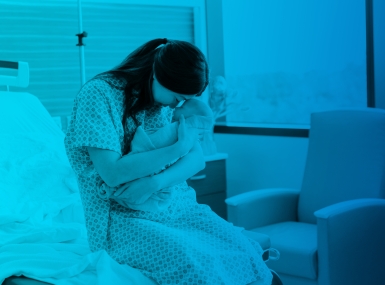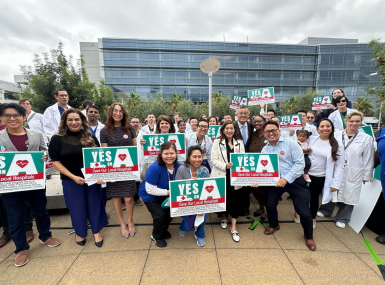Treatment and Recovery for Pregnant and Parenting People: A NACo Opioid Solutions Strategy Brief

Upcoming Events
Related News
“Rather than discouraging discussions of drug use during pregnancy, we should be looking upon them as an opportunity to bring about positive, long-lasting change in the life of the [parent] and child, through effective treatment and support services.”
– Loretta Finnegan, MD1
What is effective treatment for opioid use disorder for pregnant and parenting people?
During pregnancy, the evidence-based standard of care for opioid use disorder (OUD) is treatment with methadone or buprenorphine. These medications for opioid use disorder (MOUD) are safe to use during pregnancy and recommended by the U.S. Substance Abuse and Mental Health Services Administration (SAMSHA),2 the American Society for Addiction Medicine (ASAM)3 and the American College of Obstetricians and Gynecologists (ACOG).4
Even though MOUD is the standard of care, many pregnant and parenting people cannot access MOUD through existing healthcare infrastructures.5,6 In addition, pregnant and parenting people with OUD may avoid the healthcare system out of justified concerns about child welfare involvement and the risk of losing their children.7–10 Child removal is associated with a greater risk of accidental overdose for the birth parent11 and entry into the foster system is associated with worse outcomes for the child.12 Effective treatment for pregnant and parenting people means expanding access to MOUD and adopting a family-centered approach that prioritizes keeping families together.13,14
Click the button below to watch a short video about Eat, Sleep, Console: a family-centered program for parents and newborns affected by substance use.
What evidence supports treatment with MOUD for pregnant and parenting people?
- Methadone and buprenorphine have been used to treat OUD for decades; research consistently supports their effectiveness.15,16
- For people with OUD, receiving these medications during pregnancy improves delivery outcomes17 and reduces the risk of non-fatal overdose by as much as 97%.18
- Treating OUD with naltrexone during pregnancy is widely discouraged by medical experts.2,3,4 Only two of the three FDA-approved MOUD are recommended during pregnancy: methadone and buprenorphine.
- Attempted abstinence during pregnancy — whether through medically-assisted detoxification or at-home efforts to quit “cold turkey” — has an 85-90% failure rate.19,20 It can also increase the risk of overdose, cause fetal distress and precipitate pre-term labor.3
- Treatment during pregnancy with methadone or buprenorphine does not increase the risk of neonatal abstinence syndrome (NAS), sometimes called neonatal opioid withdrawal syndrome (NOWS). Receiving higher doses of either medication does not increase the severity or duration of NAS symptoms.21,22 Even if it does occur, NAS is a short-term, manageable condition.23,24
Are there risks to my community or institution if we don’t support treatment with MOUD for pregnant and parenting people?
Yes.
Approximately 1 in 20 pregnant people use drugs,25 meaning roughly 200,000 infants are born each year exposed to substances. The need for evidence-based treatment and recovery support for pregnant and parenting people is great, but access to MOUD is extremely poor — especially for Black and Hispanic persons of reproductive age26,27 and in regions most affected by opioid use and overdose.5 Poor MOUD access for pregnant and parenting people may result in higher social and healthcare costs for managing substance-affected pregnancies.28,29
Further, the Americans with Disabilities Act (ADA) offers protections to people who are receiving treatment for a substance use disorder. Discrimination against persons receiving MOUD treatment — including pregnant and parenting people — is considered a violation of the ADA and could be grounds for legal action.30
What are best practices to support treatment and recovery for pregnant and parenting people?
- As your state laws allow, develop a template for Plans of Safe Care for use by relevant child welfare agencies providing care for substance-affected pregnancies in your county in accordance with the Child Abuse and Prevention Treatment Act of 2016 (CAPTA). Plan of Safe Care templates help coordinate better support for families impacted by substance use and reduce unnecessary engagement with child welfare services.31
- Help secure funds to cover the cost of medications for pregnant and parenting people who may lose access to health coverage (including Medicaid) shortly after giving birth.32–34
- Support access to MOUD in rural or underserved areas by promoting telehealth,35 mobile clinics36 and other innovative approaches to serve pregnant and parenting people.37
- Expand free and affordable family housing options for pregnant and parenting people receiving treatment for OUD.14
- Fight stigma and misinformation by voicing strong support for MOUD as an evidence-based treatment for OUD during and after pregnancy. Stigma and misinformation about OUD and MOUD pose significant and persistent barriers to people getting the care they need.38
What are some examples of successful treatment and recovery programs for pregnant and parenting people?
Project CARA (Care that Advocates Respect/Resilience/Recovery for All) is a program of the Mountain Area Health Education Center, which serves pregnant people with substance use disorders in 20 western, Appalachian counties in North Carolina. Project CARA provides trauma-informed perinatal healthcare that includes MOUD treatment alongside wraparound services to address housing, transportation, food security and other social determinants of health.39
The Pregnancy Recovery Center at the University of Pittsburgh’s Magee-Women’s Hospital offers MOUD to pregnant people through patient-centered delivery of care. The Pregnancy Recovery Center care team consists of obstetric and gynecological physicians who are licensed to prescribe buprenorphine, a nurse with addiction medicine training and a social worker.40
The Maternal Opiate Medical Support (MOMS) initiative in Ohio offers MOUD to people living with OUD both during and after pregnancy through a medical care home model. MOMS also provides access to residential treatment—when residential care is indicated—that allow parents and children up to 12 years of age to continue living together.41
These and many other model programs are described online at the Brandeis Opioid Resource Connector.
Author
Jennifer J. Carroll, PhD, MPH
Dr. Carroll is a medical anthropologist, research scientist and subject matter expert on substance use and public health. She is currently an Assistant Professor of Anthropology at North Carolina State University.
Additional Resources
Educational Materials for Clinicians and General Audiences
- National Institute on Drug Abuse (NIDA) Director Dr. Nora D. Volkow, "Pregnant people with substance use disorders need treatment, not criminalization"
- National Perinatal Association, infographics on substance use during pregnancy
- National Advocates for Pregnant Women, “Understanding Opioid Use During Pregnancy”
- The Academy of Perinatal Harm Reduction, “Pregnancy and Substance Use: A Harm Reduction Toolkit"
Detailed Information for Clinicians
- U.S. Centers for Disease Control and Prevention, “Linking People with Opioid Use Disorder to Medication Treatment: A Technical Package of Policies, Programs, and Practices”
- National Perinatal Association, “NPA Position Statement on Perinatal Substance Use”
Detailed Information for Policymakers
- Office of the Assistant Secretary for Planning and Evaluation, “State Policy Levers for Expanding Family-Centered Medication-Assisted Treatment"
- National Advocates for Pregnant Women, “Issue Brief – Parenting and Drug Use”
- National Center on Substance Abuse and Child Welfare, "Building Community Support to Prevent Family Involvement in the Child Welfare System” (webinar)
- National Center on Substance Abuse and Child Welfare, “How States Serve Infants and their Families Affected by Prenatal Substance Exposure"
National Network of Perinatal Quality Collaboratives (PQCs)
PQCs consist of state-wide or multi-state networks providing resources and expertise to improve perinatal and infant health outcomes, including reducing pre-term birth, reducing racial/ethnic and geographic disparities in treatment and treatment outcomes, and improving care provided for NAS. A directory of all nation-wide PQCs can be found on the National Institute for Children’s Health Quality website.
The ORN is a technical assistance collaboration between the American Academy of Addiction Psychiatry and Columbia University. The ORN has local consultants in all 50 states and 9 U.S. territories to provide communities with technical assistance and education on the prevention and treatment of OUD.
Rural Health Information Hub (RHIhub)
RHIhub hosts a comprehensive series of online training modules and toolkits to support community leaders and healthcare practitioners in better understanding proven and available treatment strategies for pregnant and parenting people with OUD.
The Academy of Perinatal Harm Reduction (APHR):
APHR provides free educational resources for healthcare providers and pregnant patients on effective, evidence-based perinatal care in the context of substance use. APHR also offers trainings on evidence-based care of pregnant and parenting people who use drugs for healthcare professionals, social workers, lawyers and judges, community advocates and more.
- Academy of Perinatal Harm Reduction. Academy of Perinatal Harm Reduction. Academy of Perinatal Harm Reduction. Published 2022. Accessed October 10, 2022. https://www.perinatalharmreduction.org
- U.S. Substance Abuse and Mental Health Services Administration. Clinical Guidance for Treating Pregnant and Parenting Women with Opioid Use Disorder and Their Infants.; 2018. Accessed June 18, 2019. https://store.samhsa.gov/system/files/sma18-5054.pdf
- American Society of Addiction Medicine. The ASAM National Practice Guideline for the Treatment of Opioid Use Disorder: 2020 Focused Update. Published online 2020. Accessed December 8, 2021. https://www.asam.org/quality-care/clinical-guidelines/national-practice-guideline
- Committee on Obstetric Practice. Committee Opinion No. 711: Opioid Use and Opioid Use Disorder in Pregnancy. Obstet Gynecol. 2017;130(2):e81-e94. doi:10.1097/AOG.0000000000002235
- Andrilla CHA, Moore TE, Patterson DG, Larson EH. Geographic Distribution of Providers With a DEA Waiver to Prescribe Buprenorphine for the Treatment of Opioid Use Disorder: A 5-Year Update. J Rural Health. 2019;35(1):108-112. doi:10.1111/jrh.12307
- Flavin L, Malowney M, Patel NA, et al. Availability of Buprenorphine Treatment in the 10 States With the Highest Drug Overdose Death Rates in the United States. J Psychiatr Pract. 2020;26(1):17-22. doi:10.1097/PRA.0000000000000437
- Angelotta C, Weiss CJ, Angelotta JW, Friedman RA. A Moral or Medical Problem? The Relationship between Legal Penalties and Treatment Practices for Opioid Use Disorders in Pregnant Women. Womens Health Issues. 2016;26(6):595-601. doi:10.1016/j.whi.2016.09.002
- Ostrach B, Leiner C. “I didn’t want to be on Suboxone at first…” - Ambivalence in Perinatal Substance Use Treatment. J Addict Med. 2019;13(4):264-271. doi:10.1097/ADM.0000000000000491
- Terplan M, Minkoff H. Neonatal Abstinence Syndrome and Ethical Approaches to the Identification of Pregnant Women Who Use Drugs. Obstet Gynecol. 2017;129(1):164-167. doi:10.1097/AOG.0000000000001781
- Stritzel H. State-level changes in health insurance coverage and parental substance use-associated foster care entry. Social Science & Medicine. 2022;305:115042. doi:10.1016/j.socscimed.2022.115042
- Thumath M, Humphreys D, Barlow J, et al. Overdose among mothers: The association between child removal and unintentional drug overdose in a longitudinal cohort of marginalised women in Canada. Int J Drug Policy. 2021;91:102977. doi:10.1016/j.drugpo.2020.102977
- Gypen L, Vanderfaeillie J, De Maeyer S, Belenger L, Van Holen F. Outcomes of children who grew up in foster care: Systematic-review. Children and Youth Services Review. 2017;76:74-83. doi:10.1016/j.childyouth.2017.02.035
- National Perinatal Association. NPA Position Statement 2017: Perinatal Substance Use. Published online 2017. Accessed August 9, 2020. http://www.nationalperinatal.org/resources/Documents/Position%20Papers/2017_Perinatal%20Substance%20Use_NPA%20Position%20Statement.pdf
- Seibert J, Stockdale H, Feinberg R, Dobbins E, Theis E, Karon SL. State Policy Levers for Expanding Family-Centered Medication-Assisted Treatment. Published online 2019. Accessed June 20, 2022. https://aspe.hhs.gov/reports/state-policy-levers-expanding-family-centered-medication-assisted-treatment
- Mattick RP, Breen C, Kimber J, Davoli M. Methadone Maintenance Therapy Versus No Opioid Replacement Therapy for Opioid Dependence. In: Cochrane Database of Systematic Reviews. John Wiley & Sons, Ltd; 2009. Accessed January 30, 2014. http://onlinelibrary.wiley.com/doi/10.1002/14651858.CD002209.pub2/abstract
- Mattick RP, Breen C, Kimber J, Davoli M. Buprenorphine maintenance versus placebo or methadone maintenance for opioid dependence. Cochrane Database Syst Rev. 2014;(2):CD002207. doi:10.1002/14651858.CD002207.pub4
- Krans EE, Kim JY, Chen Q, et al. Outcomes associated with the use of medications for opioid use disorder during pregnancy. Addiction. 2021;116(12):3504-3514. doi:10.1111/add.15582
- Jarlenski M, Chen Q, Gao A, Rothenberger SD, Krans EE. Association of Duration of Methadone or Buprenorphine Use During Pregnancy With Risk of Nonfatal Drug Overdose Among Pregnant Persons With Opioid Use Disorder in the US. JAMA Netw Open. 2022;5(4):e227964. doi:10.1001/jamanetworkopen.2022.7964
- Lund IO, Fitzsimons H, Tuten M, Chisolm MS, O’Grady KE, Jones HE. Comparing methadone and buprenorphine maintenance with methadone-assisted withdrawal for the treatment of opioid dependence during pregnancy: maternal and neonatal outcomes. Subst Abuse Rehabil. 2012;3(Suppl 1):17-25. doi:10.2147/SAR.S26288
- Saia KA, Schiff D, Wachman EM, et al. Caring for Pregnant Women with Opioid Use Disorder in the USA: Expanding and Improving Treatment. Curr Obstet Gynecol Rep. 2016;5(3):257-263. doi:10.1007/s13669-016-0168-9
- Kaltenbach K, Holbrook A, Coyle MG, et al. Predicting Treatment for Neonatal Abstinence Syndrome in Infants Born to Women Maintained on Opioid Agonist Medication. Addiction. 2012;107(0 1):45-52. doi:10.1111/j.1360-0443.2012.04038.x
- Jones HE, Dengler E, Garrison A, et al. Neonatal outcomes and their relationship to maternal buprenorphine dose during pregnancy. Drug Alcohol Depend. 2014;134:414-417. doi:10.1016/j.drugalcdep.2013.11.006
- Nelson LF, Yocum VK, Patel KD, Qeadan F, Hsi A, Weitzen S. Cognitive Outcomes of Young Children After Prenatal Exposure to Medications for Opioid Use Disorder. JAMA Netw Open. 2020;3(3). doi:10.1001/jamanetworkopen.2020.1195
- Sujan AC, Quinn PD, Rickert ME, et al. Maternal prescribed opioid analgesic use during pregnancy and associations with adverse birth outcomes: A population-based study. PLoS Med. 2019;16(12):e1002980. doi:10.1371/journal.pmed.1002980
- Substance Abuse and Mental Health Services Administration. 2018 National Survey of Drug Use and Health (NSDUH) Releases. SAMHSA. Published 2019. Accessed November 30, 2019. http://www.samhsa.gov/data/release/2018-national-survey-drug-use-and-health-nsduh-releases
- Hadland SE, Wharam JF, Schuster MA, Zhang F, Samet JH, Larochelle MR. Trends in Receipt of Buprenorphine and Naltrexone for Opioid Use Disorder Among Adolescents and Young Adults, 2001-2014. JAMA Pediatr. 2017;171(8):747-755. doi:10.1001/jamapediatrics.2017.0745
- Khachikian T, Amaro H, Guerrero E, Kong Y, Marsh JC. Disparities in opioid treatment access and retention among women based on pregnancy status from 2006 to 2017. Drug Alcohol Depend Rep. 2022;2:100030. doi:10.1016/j.dadr.2022.100030
- Robin AM, Hersh AR, John C, Caughey AB. Cost effectiveness of buprenorphine vs. methadone for pregnant people with opioid use disorder. Journal of Maternal-Fetal & Neonatal Medicine. Published online 2021:1-9. https://pubmed.ncbi.nlm.nih.gov/33455473/
- Premkumar A, Grobman WA, Terplan M, Miller ES. Methadone, Buprenorphine, or Detoxification for Management of Perinatal Opioid Use Disorder: A Cost-Effectiveness Analysis. Obstet Gynecol. 2019;134(5):921-931. doi:10.1097/AOG.0000000000003503
- Legal Action Center. Cases Involving Discrimination Based on Treatment with Medication for Opioid Use Disorder (MOUD). Published online June 6, 2022. Accessed June 8, 2022. https://www.lac.org/assets/files/Cases-involving-denial-of-access-to-MOUD.pdf
- Child Welfare Information Gateway. Plans of Safe Care for Infants with Prenatal Substance Exposure and Their Families. Published online 2020. Accessed June 20, 2022. https://www.childwelfare.gov/pubPDFs/safecare.pdf
- Dunphy C, Peterson C, Zhang K, Jones CM. Do out-of-pocket costs influence retention and adherence to medications for opioid use disorder? Drug Alcohol Depend. 2021;225:108784. doi:10.1016/j.drugalcdep.2021.108784
- Gifford K, Walls J, Ranji U, Apr 27 IGP, 2017. Medicaid Coverage of Pregnancy and Perinatal Benefits: Results from a State Survey. KFF. Published April 27, 2017. Accessed June 8, 2022. https://www.kff.org/womens-health-policy/report/medicaid-coverage-of-pregnancy-and-perinatal-benefits-results-from-a-state-survey/
- McClellan C, Moriya A, Simon K. Users of retail medications for opioid use disorders faced high out-of-pocket prescription spending in 2011-2017. J Subst Abuse Treat. 2022;132:108645. doi:10.1016/j.jsat.2021.108645
- Clark SA, Davis C, Wightman RS, et al. Using telehealth to improve buprenorphine access during and after COVID-19: A rapid response initiative in Rhode Island. J Subst Abuse Treat. 2021;124:108283. doi:10.1016/j.jsat.2021.108283
- El-Sabawi T, Baney M, Canzater SL, Weizman S. The New Mobile Methadone Rules And What They Mean For Treatment Access | Health Affairs Forefront. Health Affairs. Published August 4, 2021. Accessed June 8, 2022. https://www.healthaffairs.org/do/10.1377/forefront.20210727.942168/full/
- Kawasaki S, Hwang G, Buckner K, et al. Collaborative health systems ECHO: The use of a tele-education platform to facilitate communication and collaboration with recipients of state targeted response funds in Pennsylvania. Subst Abus. 2022;43(1):892-900. doi:10.1080/08897077.2021.2007519
- Cernasev A, Hohmeier KC, Frederick K, Jasmin H, Gatwood J. A systematic literature review of patient perspectives of barriers and facilitators to access, adherence, stigma, and persistence to treatment for substance use disorder. Explor Res Clin Soc Pharm. 2021;2:100029. doi:10.1016/j.rcsop.2021.100029
- Mountain Area Health Education Center. Project CARA of Western North Carolina. MAHEC - Mountain Area Health Education Center. Published 2022. Accessed June 20, 2022. https://mahec.net/patient-information/ob-gyn-care/project-cara-welcome
- UPMC Magee-Women’s Hospital. Pregnancy Recovery Center. UPMC | Life Changing Medicine. Published 2022. Accessed June 20, 2022. https://www.upmc.com/locations/hospitals/magee/services/pregnancy-recovery-center
- MOMSOhio. Tools and Resources for Mom and Her Support Team. MOMSOhio. Published 2022. Accessed June 20, 2022. http://momsohio.org/
Opioid Solutions Center
NACo's Opioid Solutions Center empowers local leaders to invest resources in effective treatment, recovery, prevention and harm reduction practices that save lives and address the underlying causes of substance use disorder.


Medication-Assisted Treatment (“MAT”) for Opioid Use Disorder: A NACo Opioid Solutions Strategy Brief
The Food and Drug Administration (FDA) has approved three medications that safely and effectively treat opioid use disorder (OUD) to improve the health and wellbeing of people living with OUD. MAT is defined by on-going, long-term treatment with one of these three medications.

Treatment for Neonatal Abstinence Syndrome: A NACo Opioid Solutions Strategy Brief
Neonatal Abstinence Syndrome or NAS (also called Neonatal Opioid Withdrawal Syndrome or NOWS) is a condition that sometimes affects newborns of parents who have taken opioids during pregnancy. Because NAS does not cause long-term health consequences, treatment with MOUD – as opposed to withdrawal and abstinence – is safer for both parents and their infants.

Increasing Access to Evidence-Based Treatment: A NACo Opioid Solutions Strategy Brief
Our health care system’s capacity to provide medications for opioid use disorder (MOUD) falls far below the current demand for care. Only 1 in 4 people who need MOUD are able to access them. A multi-pronged approach is needed to build up the treatment workforce, create effective pathways to care and save lives.
Featured News

CMS issues new guidance on Medicaid Community Engagement Requirements
On December 8, the Centers for Medicare & Medicaid Services (CMS) released a Medicaid and CHIP Services Informational Bulletin (CIB) directing states on how to implement the Medicaid community engagement requirements enacted under Section 71119 of the One Big Beautiful Bill Act legislation (Public Law 119-21), or H.R. 1.

California county sales tax measure backfills federal healthcare cuts
Santa Clara County, Calif. will raise an estimated $330 million each year from a sales tax to backfill lose Medicaid funding.
